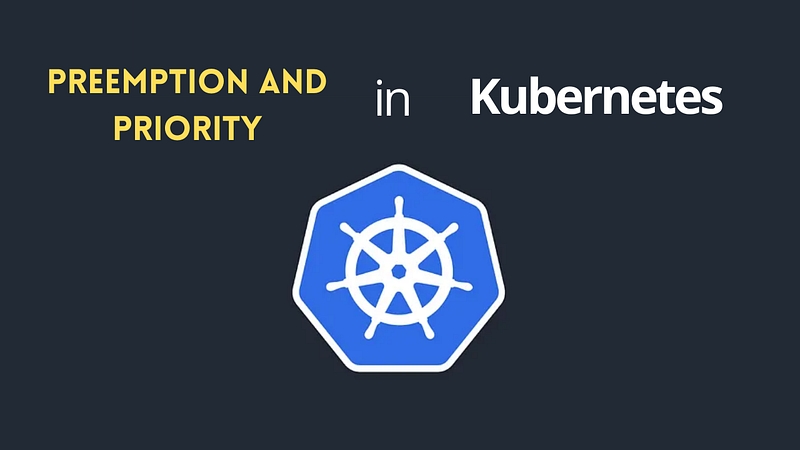Understanding Kubernetes: Part 26 Preemption and Priority

What is a Pod Priority?
A Pod Priority defines the importance of a Pod relative to others. Higher-priority Pods get scheduled before lower-priority ones. If resources are insufficient, Kubernetes may preempt (evict) lower-priority Pods to make room for higher-priority ones.
Defining a Pod Priority Class
Pod priorities are defined using PriorityClasses, which assign numerical values to indicate importance.
Example: Creating a Priority Class
apiVersion: scheduling.k8s.io/v1
kind: PriorityClass
metadata:
name: high-priority
value: 1000
preemptionPolicy: PreemptLowerPriority
globalDefault: falsevalue: Determines the priority level; higher values indicate higher priority.preemptionPolicy: Defines whether the Pod can preempt lower-priority Pods (PreemptLowerPriority).globalDefault: Iftrue, this priority applies to all Pods by default.
Assigning a Priority to a Pod
After defining a PriorityClass, assign it to a Pod:
apiVersion: v1
kind: Pod
metadata:
name: critical-app
spec:
priorityClassName: high-priority
containers:
- name: app
image: my-appThis Pod is now considered high-priority and may preempt lower-priority Pods if needed.
What is Preemption?
Preemption occurs when a high-priority Pod cannot be scheduled due to resource constraints. Kubernetes then evicts lower-priority Pods to free up resources for the high-priority Pod.
Preemption Process
A high-priority Pod cannot be scheduled due to lack of resources.
Kubernetes identifies lower-priority Pods that can be evicted.
The lower-priority Pods are terminated.
The high-priority Pod is scheduled.
Controlling Preemption
By setting preemptionPolicy: Never, you can prevent a Pod from evicting other workloads:
apiVersion: scheduling.k8s.io/v1
kind: PriorityClass
metadata:
name: non-preempting-priority
value: 500
preemptionPolicy: NeverThis ensures that Pods with this priority will not preempt lower-priority Pods.
Use Cases
1. Ensuring Critical Workloads Run First
Assign higher priority to critical applications to guarantee their availability.
2. Protecting Low-Priority Batch Jobs
Set low priority for batch processing jobs to avoid interference with real-time applications.
3. Controlled Eviction of Non-Essential Workloads
Preempt lower-priority workloads during resource shortages, ensuring vital services remain operational.
Removing a Priority Class
If a PriorityClass is no longer needed, remove it using:
kubectl delete priorityclass high-priorityThis prevents future Pods from using this priority but does not affect running Pods.
Conclusion
Kubernetes Preemption and Priority allow fine-grained control over workload scheduling, ensuring that essential applications always have the resources they need. By assigning priorities wisely, you can optimize cluster stability and resource allocation efficiently.
In My Previous Role
As a Senior DevOps Engineer, I leveraged Kubernetes Priority and Preemption to ensure efficient workload scheduling:
Critical Services: Assigned high-priority classes to essential applications to prevent downtime.
Batch Jobs: Set lower priorities for non-essential batch jobs to minimize their impact on critical workloads.
Resource Optimization: Used preemption to dynamically allocate resources based on workload demand, ensuring efficient cluster utilization.
🚀 Ready to Master Kubernetes?
Take your Kubernetes journey to the next level with the Master Kubernetes: Zero to Hero course! 🌟 Whether you’re a beginner or aiming to sharpen your skills, this hands-on course covers:
✅ Kubernetes Basics — Grasp essential concepts like nodes, pods, and services. ✅ Advanced Scaling — Learn HPA, VPA, and resource optimization. ✅ Monitoring Tools — Master Prometheus, Grafana, and AlertManager. ✅ Real-World Scenarios — Build production-ready Kubernetes setups.
🎓 What You’ll Achieve
💡 Confidently deploy and manage Kubernetes clusters. 🛡️ Secure applications with ConfigMaps and Secrets. 📈 Optimize and monitor resources for peak performance.
🔥 Start Learning Now: [Join the Master Kubernetes Course](https://cloudops0.gumroad.com/l/k8s)
Don’t miss your chance to become a Kubernetes expert! 💻✨
🚀 Stay ahead in DevOps and SRE! 🔔 Subscribe now and never miss a beat on Kubernetes and more. 🌟
🚀 Master Terraform: Infrastructure as Code
🔥 Start Learning Now: Join the Master Terraform Course
Last updated